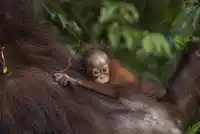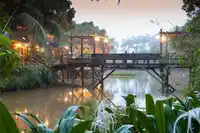
Danum Valley
One of the world’s best destinations for birding as well as seeing orangutans in the wild.
Explore Danum ValleyCelebrating our natural world heroes
Wong Siew Te is a Malaysian wildlife biologist and sun bear expert. He has been studying Bornean sun bears since 1998 in Sabah, Malaysian Borneo. He did all his B. Sc., M. Sc. And Ph.D (incomplete) at the University of Montana, USA. Wong is the CEO and the founder of the Bornean Sun Bear conservation Centre in Sabah, Malaysian Borneo, which he founded in 2008. He is also the former co-chair of the Sun Bear Expert Team, under the IUCN/SSC Bear Specialist Group and a current member of three IUCN/SSC Specialist Groups.
In 2012, Wong was recognized as a wildlife hero featured in the book Wildlife Heroes: 40 Leading Conservationists and the Animals They Are Committed to Saving. In 2014, he was conferred a Member, Order of the Defender of State (Darjah Johan Negeri, D.J.N) by the governor of Penang State.

Tell us more about the work that you do and how it supports long-term conservation efforts?
I first came to Borneo in 1998 to study the ecology of wild sun bears and I have been active in the research and conservation of sun bears ever since. In 2008, I founded the Bornean Sun Bear Conservation Centre 2008 in Sabah, Malaysia Borneo, with the objective to support sun bear conservation through a holistic approach that incorporates improving the welfare of the rescued captive sun bears, education, research, and rehabilitation. The center aims to support long-term conservation efforts on sun bears.
Do you have a single most influential or defining moment when you knew that you wanted to study and work with animals and what have been your biggest challenges?
Yes, I do. The most defining moment when I knew that I wanted to study and work with animals was when I was a kid, maybe at the age of 5 or 6. At that time, I was raising up three house sparrow chicks that fallen from their nest. One day I accidentally stepped on one of chick as they were hopping on the floor and killed her. I was so sad and wanted to save the sparrow chick so badly. Since then, I rescued and raised many wild birds, pets, and developed an ambition to be an animal expert or a veterinarian. The biggest challenges in reaching this point of my career is the shortage of financial and human resources to do all the work that we need to conserve sun bears. The task to save sun bears from extinction is a big job and typically requires a lot of funding to do all the work on the ground.
How can we change local attitudes towards nature?
Understanding; people need to understand what nature is, how nature functions, and why is nature so importance to their livelihood through education. People also need to know that we only have one nature – the Mother Earth - and there is no alternative at this moment. If we destroy nature, none of us can survive.
Understanding is the most effective approach to human-wildlife co-existence and conflict. Local people need to understand why conflicts occur, what went wrong, and how to solve the problem. Without understanding, it is very difficult to solve the problem and co-exist together.

One of the world’s best destinations for birding as well as seeing orangutans in the wild.
Explore Danum Valley
Best known for its groundbreaking work in protecting these much-loved primates.
Discover the Sanctuary
At 130 million years old, Borneo's Rainforest is one of the oldest in the world, and home to a dizzying number of species (15,000 of plants, 3,000 of trees, 221 of land mammals & 420 of birds!). As the third largest island in the world, a lot of these are endemic to Borneo alone, their natural habitat being unique and endangered. The renowned Danum Valley is a mystical and special example of this pristine environment, where you can spot a variety of Borneo's animals including, pygmy elephants and (if you are very lucky) clouded leopard skulking in the shade of lowland dipterocarps, watch orangutans and gibbons swinging in the vines, and bearded pigs and deer scarpering through the undergrowth.
Read about Borneo Rainforests
Seeing orangutans in the wild is one of the most magical experiences in Borneo. Find out where the best place is to see orangutans in the wild in Borneo and Sabah.
Read more
Borneo Rainforest Lodge is set in the fauna and flora rich Danum Valley; this rustic lodge is the perfect place to stay on a selection of bespoke Borneo holidays. The spacious main building offers an open veranda where the traveller can sit back and enjoy the incredible diversity of this forest environment whilst wooden chalets and bungalows provide comfortable lodgings for guests. The mist shrouded treetops and babbling river lull one to sleep after a day's wildlife spotting.
Read more
Surrounded by thick jungle, the wooden chalets provide great access to the rehabiliation centre.
Lodge DetailsCan we as members of the public do anything that genuinely helps preserve the natural world?
Yes, there are many things people can do to help preserve the nature world. I always tell people to “do what you do best” to help sun bears. Same here, anyone can do what they do best to help the natural world. We first start small, do what we are capable of, and slowly expend the horizon and the scope base on our capability. We need to use our creativity and imagination to figure out ways that can help the natural world. For me, I do my small part to conserve sun bears. Other can do the same too.
What have been the biggest conservation success stories that you have seen during your career?
I think is the establishment of the Bornean Sun Bear Conservation Centre (BSBCC). I see BSBCC as the hub and a catalyst to overcoming sun bear conservation issues while at the same time providing a platform to nurture and inspire more people to do the same to conserve the sun bears. It brings people closer to nature and helps them understand more about the need of the sun bear and other wildlife in the forest. Without BSBCC, many captive sun bears would still live in small cages without hope; without BSBCC many people in the world still do not know there is a bear species called the sun bear. Without BSBCC, the future of the sun bear is bleak.
Who is your own personal Natural World Hero and why?
George Schaller is my own personal Natural World Hero. He is what I called the real “Animal Expert” who is the world’s prominent field biologist, studying many wildlife species in Africa, Asia, and South America. He has been spending most of his lifetime in harsh environments in wildlife habitats to study and understand the natural histories of many magnificent mammals in the world. The information he gathered through his studies has inspired more field biologists and improved wildlife management policies.
What is your dream natural world destination that you haven’t visited yet but would like to?
Africa is my dream natural world destination. I would like to see with my own eyes all the mega fauna that I used to see on TV and in zoos in real life, and in their natural habitat. I am very familiar with these animals through wildlife documentaries but have never before experienced being with this wildlife in their native habitat.
What natural world insight would you like to leave us with?
Do what you do best to help the natural world! There is always a room for you to do something significant for a brighter future.